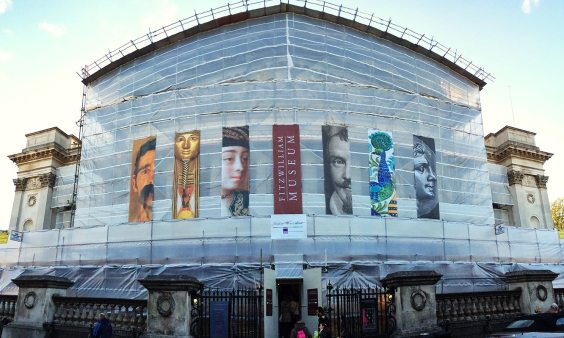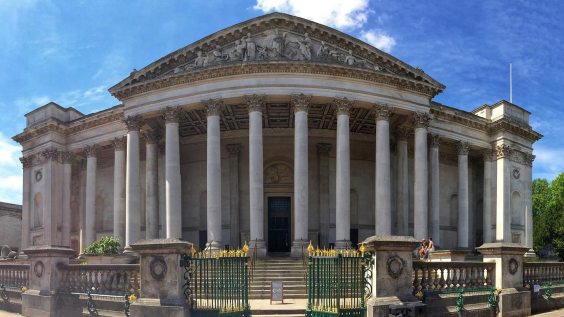The Fitzwilliam Museum in Cambridge, considered by many as one of Europe’s finest small museums, has just undergone a £500,000 restoration scheme. The main works have extended to the very fabric of the building, with more than nine tons of lead repaired on the roof, but the most noticeable change is the revival of the museum’s magnificent portico. This grand entrance and its giant columns stands as the focal point of the façade of the Founder’s Building designed by architect George Basevi in 1835, one of the country’s most significant examples of the enriched Neo-Roman manner of the 1830s–40s.

Scaffolding covering the museum (November 2013) © University of Cambridge. Photographer: Sir Cam
This very successful restoration will have a large impact on how visitors perceive their entrance into the museum. For many years, most visitors, myself included, have rushed through the gates on Trumpington Street failing to notice the intricate railings concealed by thick layers of black paint. Visitors then tended to rapidly ascend the steps through the darkened portico missing the elaborate carvings of the ceiling, hidden under dust and soot and obstructed by pigeon netting, serving the dual purpose of keeping the birds away as well as catching falling pieces of 19th-century plasterwork. The visitors’ first sense of awe would only be experienced once confronted with the main entrance foyer with its staircase rivalling that of the Palais Garnier, the dome supported by telamones, the luxurious variety of precious marbles and pairs of caryatids leading to the grand exhibition galleries.
The portico’s careful restoration has saved it from potential catastrophe: leaks from the roof had severely undermined the structural integrity of the plastered coffered ceiling, with the giant plaster lotus flowers even menacing to fall. They not only risked shattering on the ground but maybe even on a visitor’s head. The restoration also helps to highlight the coherence of the original design. Visitors can now clearly progress from the railings on the street with their pineapple finials, to the plastered coffered ceiling repeating the motif along with a variety of plump fruit, lush foliage and wild animals, to the refinement and sheer exuberance of the entrance hall.
The restoration is as remarkable for the care and precision that has gone into it as its finished appearance. The layers of paint on the railings, fine examples of early 19th-century ironwork, were analysed in order to find their original colour, a bronze green and gold for certain elements. The railings were repainted in that green, originally aimed at imitating patinated bronze, while the wavy spikes topping them and large pineapple finials were highlighted with gold leaf. The coffered ceiling, adorned with a cornucopia of pineapples, melons, grapes, and apples, in such abundance that they seem to be almost bursting out of their frames, was restored, cleaned and consolidated. The same goes for the frieze spanning all round the top of the walls of the portico, depicting a playfully intricate combination of putti and their dogs chasing stags, boars and other wild animals amidst a lush stylised foliage of acanthus leaves. The museum produced a series of panoramas before taking down the scaffolding allowing the viewer to fully appreciate the virtuosity of the design.
This restoration project marks the first step of the Fitzwilliam Museum’s regeneration under the directorship of Tim Knox, who was appointed last year. With the museum’s bicentenary rapidly approaching in 2016 one can only eagerly hope it will help to enable a similarly respectful and meticulous restoration of the museum’s main galleries. Soon after his appointment Knox said: ‘I want to reassert the importance of our grand Founder’s entrance. I don’t see monumental porticoes as elitist or intimidating – we want people to revel in the opulence and magnificence of the museum. The entrance hall gives the Paris Opéra a run for its money, and yet the museum is free to visit and we want everyone to feel welcome in this wonderful setting’. He added ‘I want to make the place sing.’ This beautiful restoration can be seen as a first step towards doing just that.
The Fitzwilliam Museum is in Cambridge, UK

Restored portico © University of Cambridge. Photographer: Sir Cam

Making an entrance: the Fitzwilliam Museum’s opulent portico has been restored
The Fitzwilliam Museum in Cambridge. © University of Cambridge. Photographer: Sir Cam
Share
The Fitzwilliam Museum in Cambridge, considered by many as one of Europe’s finest small museums, has just undergone a £500,000 restoration scheme. The main works have extended to the very fabric of the building, with more than nine tons of lead repaired on the roof, but the most noticeable change is the revival of the museum’s magnificent portico. This grand entrance and its giant columns stands as the focal point of the façade of the Founder’s Building designed by architect George Basevi in 1835, one of the country’s most significant examples of the enriched Neo-Roman manner of the 1830s–40s.
Scaffolding covering the museum (November 2013) © University of Cambridge. Photographer: Sir Cam
This very successful restoration will have a large impact on how visitors perceive their entrance into the museum. For many years, most visitors, myself included, have rushed through the gates on Trumpington Street failing to notice the intricate railings concealed by thick layers of black paint. Visitors then tended to rapidly ascend the steps through the darkened portico missing the elaborate carvings of the ceiling, hidden under dust and soot and obstructed by pigeon netting, serving the dual purpose of keeping the birds away as well as catching falling pieces of 19th-century plasterwork. The visitors’ first sense of awe would only be experienced once confronted with the main entrance foyer with its staircase rivalling that of the Palais Garnier, the dome supported by telamones, the luxurious variety of precious marbles and pairs of caryatids leading to the grand exhibition galleries.
The portico’s careful restoration has saved it from potential catastrophe: leaks from the roof had severely undermined the structural integrity of the plastered coffered ceiling, with the giant plaster lotus flowers even menacing to fall. They not only risked shattering on the ground but maybe even on a visitor’s head. The restoration also helps to highlight the coherence of the original design. Visitors can now clearly progress from the railings on the street with their pineapple finials, to the plastered coffered ceiling repeating the motif along with a variety of plump fruit, lush foliage and wild animals, to the refinement and sheer exuberance of the entrance hall.
The restoration is as remarkable for the care and precision that has gone into it as its finished appearance. The layers of paint on the railings, fine examples of early 19th-century ironwork, were analysed in order to find their original colour, a bronze green and gold for certain elements. The railings were repainted in that green, originally aimed at imitating patinated bronze, while the wavy spikes topping them and large pineapple finials were highlighted with gold leaf. The coffered ceiling, adorned with a cornucopia of pineapples, melons, grapes, and apples, in such abundance that they seem to be almost bursting out of their frames, was restored, cleaned and consolidated. The same goes for the frieze spanning all round the top of the walls of the portico, depicting a playfully intricate combination of putti and their dogs chasing stags, boars and other wild animals amidst a lush stylised foliage of acanthus leaves. The museum produced a series of panoramas before taking down the scaffolding allowing the viewer to fully appreciate the virtuosity of the design.
This restoration project marks the first step of the Fitzwilliam Museum’s regeneration under the directorship of Tim Knox, who was appointed last year. With the museum’s bicentenary rapidly approaching in 2016 one can only eagerly hope it will help to enable a similarly respectful and meticulous restoration of the museum’s main galleries. Soon after his appointment Knox said: ‘I want to reassert the importance of our grand Founder’s entrance. I don’t see monumental porticoes as elitist or intimidating – we want people to revel in the opulence and magnificence of the museum. The entrance hall gives the Paris Opéra a run for its money, and yet the museum is free to visit and we want everyone to feel welcome in this wonderful setting’. He added ‘I want to make the place sing.’ This beautiful restoration can be seen as a first step towards doing just that.
The Fitzwilliam Museum is in Cambridge, UK
Restored portico © University of Cambridge. Photographer: Sir Cam
Unlimited access from just $16 every 3 months
Subscribe to get unlimited and exclusive access to the top art stories, interviews and exhibition reviews.
Share
Recommended for you
The Hague’s hidden treasures: Museum Bredius
There’s more to the Hague than the Mauritshuis
Apollo 40 Under 40: The Artists
Try making a list of 10 outstanding young artists, all based in Europe, and whose work already announces their original talent but also bears the promise of longevity. Where would you start?
A good advert for American art? Art Everywhere in the US
Can art add sparkle to the USA’s advertising billboards?